Exploring the Properties and Applications of Chloro Methyl Isothiazolinone in Industrial Formulations
Chloro Methyl Isothiazolinone Properties, Uses, and Safety Concerns
Chloro methyl isothiazolinone (CMI) is a widely used biocide known for its effectiveness in preventing bacterial and fungal growth in a variety of industrial and consumer products. As a water-soluble preservative, CMI is often found in cosmetics, personal care items, household cleaners, and industrial applications. Its unique chemical structure, which includes a thiazole ring, contributes to its potent antimicrobial properties, making it an essential ingredient in formulations requiring preservation.
The primary function of CMI is to inhibit microbial growth and prolong the shelf life of products. In the cosmetic industry, it is often used in creams, shampoos, and lotions to prevent spoilage from bacteria and fungi. Similarly, in household cleaning products, it serves to maintain product integrity and efficacy by deterring microbial growth that can lead to unpleasant odors or product degradation. Moreover, CMI is used in paper manufacturing, oil drilling, and other industrial processes where microbial contamination can pose significant challenges.
Despite its effectiveness, the use of chloro methyl isothiazolinone is not without controversy. Concerns have arisen regarding its safety, particularly in cosmetics and personal care products. The compound has been associated with skin sensitization and allergic reactions, leading regulatory bodies in some regions to impose restrictions on its usage. For example, the European Union has classified CMI as a substance of very high concern, regulating its concentration in consumer products to minimize potential health risks. This scrutiny highlights the delicate balance between the benefits of antimicrobial properties and the potential adverse effects on human health and the environment.
chloro methyl isothiazolinone

One of the significant issues surrounding CMI is its potential to cause allergic reactions in sensitive individuals. Prolonged or repeated exposure can lead to contact dermatitis, characterized by skin irritation, rashes, and inflammation. Additionally, there have been reports of respiratory issues upon exposure to products containing this preservative. As a result, many manufacturers have begun to reformulate their products, opting for alternatives that are perceived to be safer or less irritating. The shift away from CMI is part of a broader trend in the cosmetic and personal care industry toward clean beauty, where consumers increasingly seek out products with safer, more natural ingredients.
Manufacturers are now exploring a range of alternatives to CMI, including natural preservatives derived from plants, essential oils, and other synthetic compounds that offer similar antimicrobial benefits with reduced health risks. These alternatives are often marketed as part of eco-friendly and sustainable practices, aligning with consumer demand for transparency and safety in product formulation. However, it is crucial for manufacturers and consumers to conduct thorough research on the effectiveness and safety of these substitutes, as not all alternatives may provide the same level of protection against microbial growth.
In conclusion, chloro methyl isothiazolinone serves a vital role in preserving the integrity of countless products across various industries. While its effectiveness as a biocide is well-documented, growing concerns regarding its potential health impacts have prompted significant scrutiny and a move toward safer alternatives. As the beauty and personal care industries continue to evolve with a focus on consumer safety and environmental responsibility, understanding both the benefits and drawbacks of CMI becomes increasingly important. Ongoing research and regulatory efforts will play a critical role in ensuring that the products we use daily remain safe and effective while addressing health and environmental concerns.
-
Water Treatment with Flocculant Water TreatmentNewsJun.12,2025
-
Polymaleic AnhydrideNewsJun.12,2025
-
Polyaspartic AcidNewsJun.12,2025
-
Enhance Industrial Processes with IsothiazolinonesNewsJun.12,2025
-
Enhance Industrial Processes with PBTCA SolutionsNewsJun.12,2025
-
Dodecyldimethylbenzylammonium Chloride SolutionsNewsJun.12,2025





